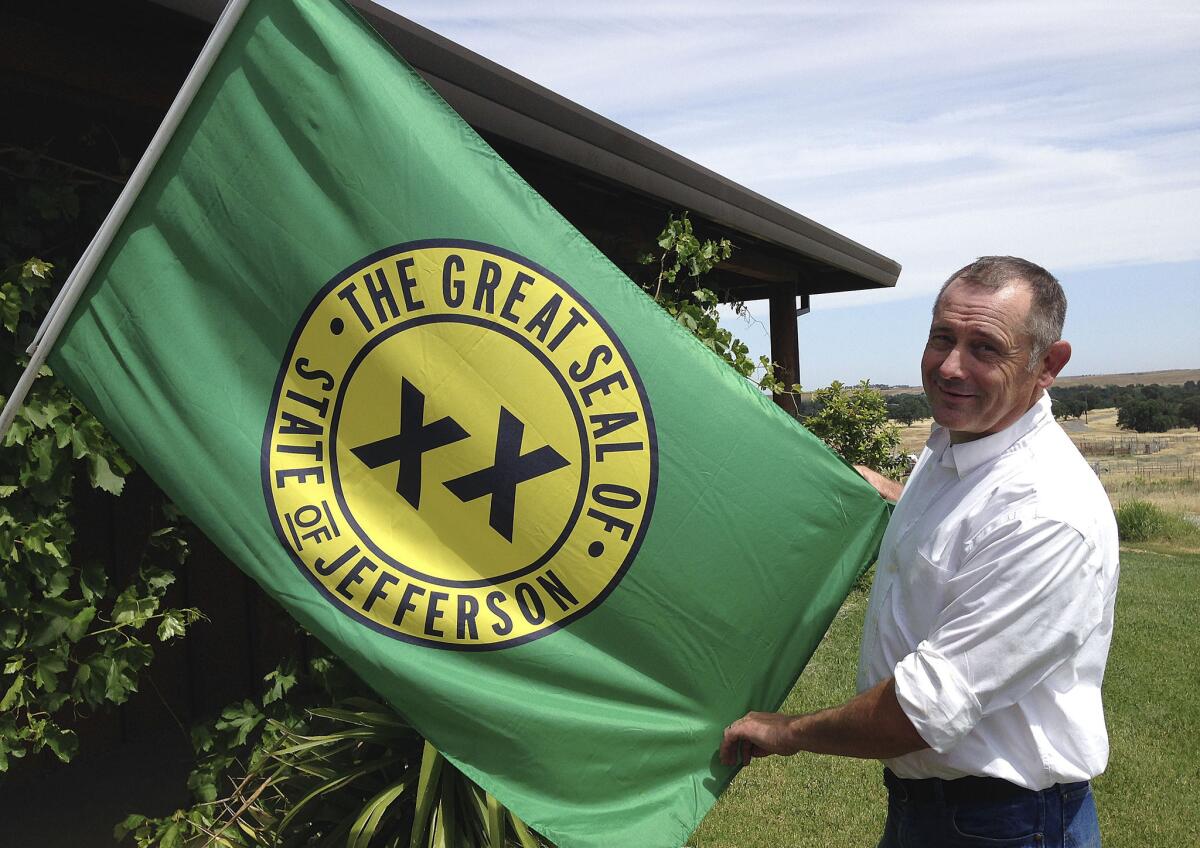51st state among local measures put to voters across California

- Share via
Reporting from SAN FRANCISCo — The longshot “State of Jefferson” gained a northern county in its camp of backers — and was rebuked by another.
Lake County marijuana grows were curtailed, while an effort to restore the health of Clear Lake fell short.
And in San Francisco and San Diego, voters weighed in on contentious development issues.
Tuesday’s election presented Californians with a host of local measures that touched on identity — and voters spoke.
In Del Norte County, they rejected the campaign to form a 51st state, defeating a measure that would have given the Board of Supervisors the green light to back the venture.
Boards in Siskiyou, Modoc, Glenn and Yuba counties have voted since last fall to support the breakaway concept, saying rural regions are underrepresented, over-regulated and dominated by urban policies.
But in Del Norte and Tehama counties, elected leaders put the issue on the ballot, saying they would follow the lead of the people.
Del Norte’s “Keep It California” campaign argued that poverty would only worsen without California’s hefty annual subsidy, and that logic prevailed. But in Tehama County, an identical measure won handily.
Mark Baird, a Yreka rancher who has helped forge the grass-roots movement, said he is undaunted.
“I don’t feel bad about Del Norte County,” said Baird, who noted that Butte and Sutter county supervisors will soon vote on the issue. “I feel sorry for Del Norte County because … the status quo there doesn’t work. Their economy is in the toilet, businesses are leaving, children are leaving.”
If enough counties back the notion, proponents will press for a vote of approval from the state Legislature and Congress.
In Lake County, voters in a referendum backed an ordinance that bans outdoor marijuana cultivation in populated areas, limits plant density elsewhere and caps indoor grows. The Board of Supervisors had adopted the ordinance last winter but a coalition of medical marijuana supporters placed the referendum on the ballot to challenge it — and lost.
Meanwhile, a sales tax measure that would have dedicated revenue toward cleaning up Clear Lake’s weeds and algae blooms failed to reach the two-thirds approval for passage.
“The lake has always been the backbone of what we are here. It’s been our identity,” said Bill Brunetti, a disappointed 30-year resident and community activist who backed the measure and said the search for existing revenues to help the ailing lake will continue.
In San Francisco, the skyline was the hot topic with voters approving a measure that would require waterfront development proposals on Port of San Francisco property that exceed set height limits of 40 to 82 feet to go before voters.
In Santa Cruz County, Watsonville voters backed a measure requiring ballot approval for name changes to public places. It stemmed from a battle over a 2010 proposal to name the city plaza after farmworker rights activist Dolores Huerta.
Voters in the Latino-majority town also took away the City Council’s power to pick a mayor and fill vacancies by appointment. The measures pitted the city’s old guard against the new, with some contending they amount to an end-run around district council leadership.
And in San Diego, voters rejected propositions that would have rezoned the blue-collar neighborhood of Barrio Logan to restrict industry and encourage housing and shopping.
The measures were opposed by Mayor Kevin Faulconer and others who said the rezoning would cost jobs and possibly imperil the future of San Diego’s shipyards. Opponents said the claims were overstated.
Barrio Logan was host to the rise of Chicano political power, notably when residents in 1970 blocked bulldozers for days to prevent state construction of a highway patrol facility: The property is now a park featuring murals that celebrate Chicano and Mexican history.
The rezoning plan took a decade to develop but Faulconer has promised to renew the process to find a compromise.
In a tweet, City Council President Todd Gloria, who supported the measures, decried “money and lies used to undermine planning and democratic processes. The City Council will not forget Barrio Logan.”
Romney reported from San Francisco, Perry from San Diego.
More to Read
Sign up for Essential California
The most important California stories and recommendations in your inbox every morning.
You may occasionally receive promotional content from the Los Angeles Times.













